
Airmodel 1/72 IMAM Ro-43
| KIT #: | ? |
| PRICE: | 12 Euros (about $18.00) |
| DECALS: | None provided |
| REVIEWER: | Carmel J. Attard |
| NOTES: | Vacuformed plastic with resin detail parts |

| HISTORY |
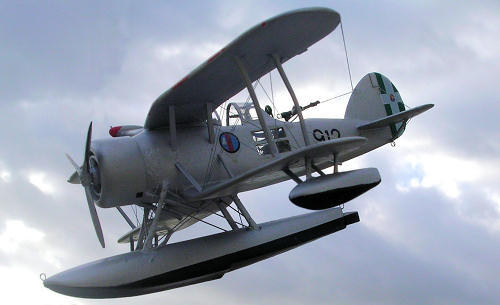 The
Ro-43 was a 2-seat Italian Navy floatplane of the 30s. It had a single,
centrally positioned float and two other mini floats under the mainplanes. At
its time of service it was a common to spot the Italian floatplane flying over
many areas of the
The
Ro-43 was a 2-seat Italian Navy floatplane of the 30s. It had a single,
centrally positioned float and two other mini floats under the mainplanes. At
its time of service it was a common to spot the Italian floatplane flying over
many areas of the
| THE KIT |
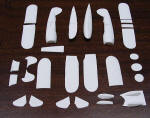 The
kit comes in vacform moulded white plastic, soft and reasonably thick and with a
minimum of surface detail. No decals are included it is suggested in the
instruction sheet that these can be acquired from Micro Scale/Superscale sheet
72-57. There are 28 vacform plastic pieces to form the fuselage halves, wing
parts and tailplane options since two different tail fin and rudder designs are
included. There are also thirty tree resin parts and three clear acetate parts.
The Airmodel
kit of the Ro-43 was the first of its type to appear at
The
kit comes in vacform moulded white plastic, soft and reasonably thick and with a
minimum of surface detail. No decals are included it is suggested in the
instruction sheet that these can be acquired from Micro Scale/Superscale sheet
72-57. There are 28 vacform plastic pieces to form the fuselage halves, wing
parts and tailplane options since two different tail fin and rudder designs are
included. There are also thirty tree resin parts and three clear acetate parts.
The Airmodel
kit of the Ro-43 was the first of its type to appear at
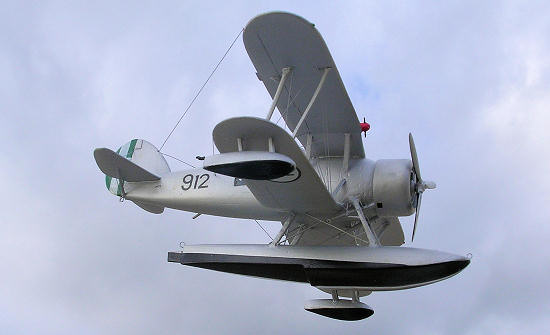 the
scale of 1/72 and goes back to over 20 years since when it was released.
Recently however it was reworked to include resin parts. In doing so Airmodel
has simplified the task of building the otherwise a vacform kit since all the
intricate parts as seats, struts, propeller, engine and cowling, exhaust pipes,
were all made in resin.
the
scale of 1/72 and goes back to over 20 years since when it was released.
Recently however it was reworked to include resin parts. In doing so Airmodel
has simplified the task of building the otherwise a vacform kit since all the
intricate parts as seats, struts, propeller, engine and cowling, exhaust pipes,
were all made in resin.
The three-page double-sided instruction sheet printed in black and white reveals four side views with different marking scheme to select from and which are basically in overall silver but with high visibility red stripe diagonal markings over the main planes. Also depicted is an enlarged drawing of the crest of Savoia and another of the fuselage fasces. There is also an enlarged four view drawing of the beaching trolley as well as a 1/72-scale drawing repeated to the kit scale of 1/72. This was very helpful to enable scratch build the trolley from the backing surplus plastic that comes with the kit. Other details shown are the instrument panel, a section drawing of the fuselage to assist with placing the crew seats at the correct place, drawing and photo of the aft gunner position. On the same page there is a 3-view drawing of the Ro-43 with folded wings for those interested to build their kit in this format and a three view drawing of the aircraft itself with the wings in the proper order.
| CONSTRUCTION |
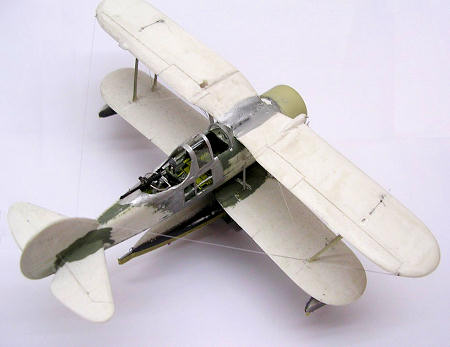 The kit
is small in size and possibly ideal for those who never made a vacform kit.
Being soft plastic it was easy to produce the razor sharp trailing edges by
scraping with an exacto knife and then rescribeing the ailerons and elevator
outlines. Rather thick clear acetate provided the cockpit two piece canopies and
careful cutting produced the desired shapes of canopy front and rear parts. Like
any vacform kit there obviously are no locating pins but guide lugs inside of
the joint line were added from scrap plastic card. The upper gull wing also
comes in several pieces, but this was no hard task to produce a complete set,
which conforms to the scale plans provided. The lower wing was inverted gull and
again scale plans are referred to when it comes to fix these in position.
Attaching both wings to the fuselage also leaves a gap at the edge that needs to
be faired over with putty. It was noted at this stage that the clear Perspex
window intended to fit to the side fuselage were rather small for the opening
provided. I found best to ignore these co
The kit
is small in size and possibly ideal for those who never made a vacform kit.
Being soft plastic it was easy to produce the razor sharp trailing edges by
scraping with an exacto knife and then rescribeing the ailerons and elevator
outlines. Rather thick clear acetate provided the cockpit two piece canopies and
careful cutting produced the desired shapes of canopy front and rear parts. Like
any vacform kit there obviously are no locating pins but guide lugs inside of
the joint line were added from scrap plastic card. The upper gull wing also
comes in several pieces, but this was no hard task to produce a complete set,
which conforms to the scale plans provided. The lower wing was inverted gull and
again scale plans are referred to when it comes to fix these in position.
Attaching both wings to the fuselage also leaves a gap at the edge that needs to
be faired over with putty. It was noted at this stage that the clear Perspex
window intended to fit to the side fuselage were rather small for the opening
provided. I found best to ignore these co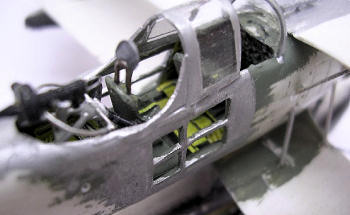 mpletely
and go about it by fixing a cross form of plastic piece and fill the 4 square
empty spaces with Kristal Kleer at a later stage.
mpletely
and go about it by fixing a cross form of plastic piece and fill the 4 square
empty spaces with Kristal Kleer at a later stage.
The kit struts are supplied
in resin. These were discarded as these were mismatched at the joint. I used
Contrail struts, the type available at Roll Models. In the end I added detail,
which was accessible to the cockpit and aft of cabin, gunner area. This detail
was added to cockpit floor and around the resin seats. The resin cowling
complete with engine detail was carefully aligned with the fuselage and secured
with a drop of Super glue. The prop was left till the final end. The final stage
was applying rigging, which was conducted in the normal way using invisible
nylon thread passed through predrilled tiny holes.
| COLORS & MARKINGS |
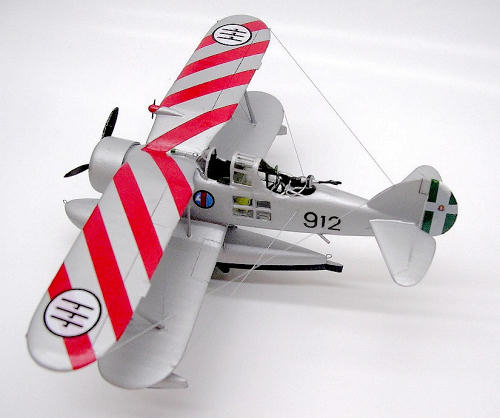 The
painted job should not deter anyone from doing a neat model. The way to go about
it was first to mask the cockpit canopy area and airbrush the wings in semi matt
white. The wing was then given two coats of bright red finish from the Model
Master selection. After allowing this to dry I masked the diagonal stripes with
the correct width of masking tape. Incidentally there were variations of
diagonal designs and some were narrower and more frequent while others were
broader and less frequent. Correct reference is highly recommended to end up
with an authentically finished model. The lower half of the floats were
airbrushed in matt black to simulate anti corrosion bitumen paint familiar with
all Italian flying boats as it was an effective way to protect the alum alloy
construction of the floatplanes from sea water corrosion. The floats were then
masked.
The
painted job should not deter anyone from doing a neat model. The way to go about
it was first to mask the cockpit canopy area and airbrush the wings in semi matt
white. The wing was then given two coats of bright red finish from the Model
Master selection. After allowing this to dry I masked the diagonal stripes with
the correct width of masking tape. Incidentally there were variations of
diagonal designs and some were narrower and more frequent while others were
broader and less frequent. Correct reference is highly recommended to end up
with an authentically finished model. The lower half of the floats were
airbrushed in matt black to simulate anti corrosion bitumen paint familiar with
all Italian flying boats as it was an effective way to protect the alum alloy
construction of the floatplanes from sea water corrosion. The floats were then
masked.
The kit was finally
airbrushed in a shade of silver to simulate anodized aluminium since it operated
over the Mediterranean waters. I found best to mix silver with a few drops of
white and double the drops of clear satin varnish. These were thinned down with
white spirit and airbrushed using XF fine Badger spray nozzle. I used markings
for the kit from various sources found in my spares decal box. The Ro-43 scale
model was finally given a coat of clear satin varnish and displayed on the
beaching trolley.
| CONCLUSIONS |
For once more, this was a vacform kit I enjoyed building and here I must say that this was not quite a straightforward job that I am more familiar with when making biplanes and certainly it is not one that can be recommended for the novice modeller. While this is a kit that can demand a great deal of care and attention, the result is very worthwhile, both as a replica of an aircraft which had a firm place in aviation history and as a model in its own right and it is recommended for modelers with an interest in this period of early in the war years.
September 2009
Copyright ModelingMadness.com. All rights reserved. No reproduction in part or in whole without express permission from the editor.
If you would like your product reviewed fairly and quickly, please contact the editor or see other details in the Note to Contributors.